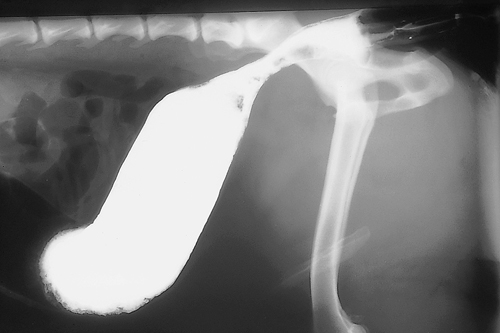Small Animal Abdominal and Metabolic Disorders Q&A 18
| This question was provided by Manson Publishing as part of the OVAL Project. See more Small Animal Abdominal and Metabolic Disorders Q&A. |
An eight-year-old Springer Spaniel is presented with constipation of several months’ duration. Constipated faeces were palpable on rectal examination. Physical examination was otherwise unremarkable. A barium enema was given and this radiograph was obtained.
| Question | Answer | Article | |
| What is your interpretation of the radiograph? | The colon is markedly dilated along its entire length. The colonic walls are smooth but there does appear to be a narrowing of the colon at the pelvic inlet. This would be consistent with stricture formation, but may also be seen when the colon has not been adequately filled with barium, or if there is a peristaltic wave passing down the colon. After administration of more barium this narrowed area disappeared, suggesting that it was artefactual rather than due to a stricture. |
Link to Article | |
| What are the causes of this condition? | Megacolon is diffuse dilation of the colon with ineffective motility. It may occur secondary to mechanical (intramural/extramural masses, foreign bodies) or functional (hypokalaemia or hypothyroidism) obstructions which prevent defecation for prolonged periods. In this case no underlying disorder was found. |
Link to Article | |
| What treatment would you suggest? | Treatment is often unsuccessful. High-fibre diets which bulk up faeces may be useful where there is some residual motor function. An increase in colonic volume is more likely to stimulate peristalsis than an empty colon. In some cases, highly digestible low-fibre diets, which produce little residue, are more helpful. Laxatives such as liquid paraffin or docusate sodium are required to ensure the faeces remain soft. Where medical therapy fails, subtotal colectomy is the only remaining option. |
Link to Article | |
